| Listing 1 - 10 of 11 | << page >> |
Sort by
|
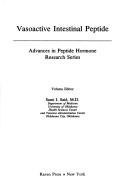
ISBN: 0890044430 Year: 1982
Abstract | Keywords | Export | Availability | Bookmark
 Loading...
Loading...Choose an application
- Reference Manager
- EndNote
- RefWorks (Direct export to RefWorks)
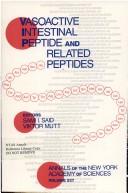
ISBN: 0897664493 0897664507 Year: 1988 Volume: 527 Publisher: New York New York Academy of sciences
Abstract | Keywords | Export | Availability | Bookmark
 Loading...
Loading...Choose an application
- Reference Manager
- EndNote
- RefWorks (Direct export to RefWorks)
Gastroenterology --- Neuropeptides --- Peptide hormones --- Vasoactive intestinal peptide --- Vasoactive Intestinal Peptide --- VASOACTIVE INTESTINAL PEPTIDE --- congresses. --- Congresses. --- Vasoactive intestinal peptides --- Congresses

ISBN: 0897669835 0897669843 Year: 1997 Volume: 805
Abstract | Keywords | Export | Availability | Bookmark
 Loading...
Loading...Choose an application
- Reference Manager
- EndNote
- RefWorks (Direct export to RefWorks)
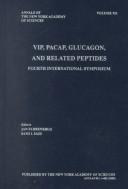
ISBN: 1573312746 Year: 2000 Volume: 921 Publisher: New York New York Academy of Sciences
Abstract | Keywords | Export | Availability | Bookmark
 Loading...
Loading...Choose an application
- Reference Manager
- EndNote
- RefWorks (Direct export to RefWorks)
Adenylate cyclase --- Peptide hormones --- Pituitary hormones --- Vasoactive intestinal peptide --- Vasoactive intestinal peptides --- Congresses
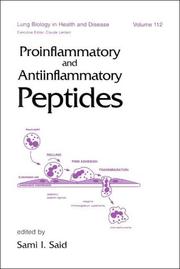
ISBN: 0824701208 Year: 1998 Publisher: New York, NY : Marcel Dekker,
Abstract | Keywords | Export | Availability | Bookmark
 Loading...
Loading...Choose an application
- Reference Manager
- EndNote
- RefWorks (Direct export to RefWorks)
INFLAMMATION MEDIATORS --- TISSUES --- CELLS --- SUBSTANCE P --- VASOACTIVE INTESTINAL PEPTIDE --- ENDOTHELINS --- ALPHA-MSH --- TACHYKININS --- PATHOLOGY --- PATHOLOGY --- INFLAMMATION MEDIATORS --- TISSUES --- CELLS --- SUBSTANCE P --- VASOACTIVE INTESTINAL PEPTIDE --- ENDOTHELINS --- ALPHA-MSH --- TACHYKININS --- PATHOLOGY --- PATHOLOGY
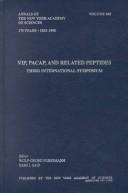
ISBN: 1573311545 Year: 1998 Volume: 865
Abstract | Keywords | Export | Availability | Bookmark
 Loading...
Loading...Choose an application
- Reference Manager
- EndNote
- RefWorks (Direct export to RefWorks)
Adenylate cyclase --- Peptide hormones --- Pituitary hormones --- Vasoactive intestinal peptide --- Agonists --- Congresses. --- Physiological effect --- Congresses --- Vasoactive intestinal peptides
Book
Year: 2020 Publisher: Basel, Switzerland MDPI - Multidisciplinary Digital Publishing Institute
Abstract | Keywords | Export | Availability | Bookmark
 Loading...
Loading...Choose an application
- Reference Manager
- EndNote
- RefWorks (Direct export to RefWorks)
In recent years, peptides have received increased interest from the pharmaceutical industry. The high potency, specificity, and safety profile are the main strengths of bioactive peptides as new and promising therapies that may fill the gap between small molecules and protein drugs. These positive attributes have renewed interest in the discovery, optimization, and development of peptides as pharmacological therapy. Among bioactive peptides, those released from food sources have acquired importance as nutraceutical and active components in functional foods because they possess regulatory functions that can lead to health benefits. This Special Issue covers a selection of recent research papers and reviews in the field of bioactive peptides. It covers all aspects of peptide research in relation to health promotion. In particular, it emphasizes current knowledge and research trends concerning bioactive peptides, including identification and quantification of peptides from new sources, methods for their production and purification, structure–function relationships, mechanisms of action, in vitro and in vivo assays for the evaluation of their bioactivity, physiological evidence to support health benefits, and peptide stability and bioavailability. Papers regarding the development of new drugs, functional foods, or nutraceuticals based on bioactive peptides were also considered.
Research & information: general --- Biology, life sciences --- antihypertensive peptides --- functional food --- food-derived --- fermentation --- Chlorella sorokiniana --- in silico --- BIOPEP-UWM database --- proteomics --- bioactive peptides --- nano liquid chromatography tandem mass spectrometry (nanoLC–nanoESI MS/MS) --- apolipoprotein E --- amyloid fibrils --- Alzheimer’s disease --- Αβ oligomer --- amyloid --- Aβ peptide --- glioma --- platelets --- antiproliferative assay --- conjugation --- docetaxel --- doxorubicin --- extra domain B --- fibronectin --- Fmoc/tBu --- peptide–drug conjugate --- prostate cancer --- solid-phase synthesis --- targeting --- acrylamide --- enteric nervous system --- galanin --- pig --- stomach --- formyl peptide receptors --- ligands --- diseases --- polymicrobial biofilms --- intragenic antimicrobial peptide --- Hs02 --- Pseudomonas aeruginosa --- Staphylococcus aureus --- osteostatin --- arthritis --- inflammation --- immune response --- cartilage destruction --- bone erosion --- collagen --- hydrolysis --- enzyme --- molecular weight --- sheepskin --- NF-κB --- dry-cured pork ham --- angiotensin I converting enzyme --- endothelial dysfunction --- molecular blind docking --- Lactoferricin B (Lfcin B) --- Histatin-5 --- antimicrobial peptides (AMPs) --- antifungal activity --- proteome microarray --- synergy --- temporin --- MRSA --- antimicrobial peptide --- human keratinocytes --- pseudin-2 --- antisepsis, peptide antibiotics --- neurotensin --- asthma --- T cells --- In situ tetramer staining --- MHC tetramer --- antigen-specific --- confocal microscopy --- fresh tissue --- velvet antler --- alcalase hydrolysate --- antioxidant peptide --- protection ability --- oxidative stress --- Crassostrea angulata --- pidotimod --- CXCR3 --- monocyte --- migration --- PI3K/Akt pathway --- T cell --- immunomodulant --- host defense peptides --- membrane activity --- copper --- piscidins --- Clostridioides difficile --- prolactin-releasing peptide --- GPR10 --- RF-amide peptides --- food intake regulation --- energy expenditure --- neuroprotection --- signaling --- gender differences --- dyslipidemia --- obesity --- hyperglycemia --- pulmonary emphysema --- endothelial progenitor cells --- angiogenic precursor cells --- pegylated glucagon-like peptide 1 --- and endothelial regeneration --- miiuy croaker (Miichthys miiuy) --- swim bladder --- FPYLRH --- antioxidant activity --- cytoprotective effect --- antimicrobial peptides --- antimicrobial resistance --- AMP identification and design --- biosynthesis --- mode of action --- physico-chemical properties --- therapeutic potential --- insects --- Cecropins --- Cec-analogs --- MDR infectious diseases --- airway inflammation --- non-atopic asthma --- hybrid peptide --- pro-inflammatory cytokines --- sPLA2 --- MDA --- database --- proteolysis --- SMILES code --- foods --- nutrition --- chronic diseases --- nutraceuticals --- peptide vaccine --- immune checkpoint inhibitor --- humanized mouse --- cancer antigen --- immune suppression --- vasoactive intestinal peptide --- VPAC1 receptor --- VPAC2 receptor --- rheumatic diseases --- inflammatory bowel disease --- central nervous system diseases --- type 1 diabetes --- Sjögren’s syndrome --- biomarkers --- human antimicrobial peptides --- defensins --- cathelicidins --- anti-inflammatory --- pro-inflammatory --- peptide --- combinatorial library --- library design --- screening --- mutagenesis --- prolyl-hydroxyproline (Pro-Hyp) --- hydroxyprolyl-glycine (Hyp-Gly) --- collagen peptide --- fibroblasts --- fetal bovine serum (FBS) --- AMD --- CNV --- VEGFR1 --- multimeric peptides --- oral delivery --- colorectal cancer --- cancer stem cells --- chemoprevention --- bioactive peptide --- lunasin --- ACE-inhibitory activity --- whey peptides --- molecular docking --- hypertension --- antibiotic resistance --- cystic fibrosis --- cryptides --- anti-biofilm peptides --- synergistic effects --- n/a --- nano liquid chromatography tandem mass spectrometry (nanoLC-nanoESI MS/MS) --- Alzheimer's disease --- peptide-drug conjugate --- Sjögren's syndrome
Book
Year: 2020 Publisher: Basel, Switzerland MDPI - Multidisciplinary Digital Publishing Institute
Abstract | Keywords | Export | Availability | Bookmark
 Loading...
Loading...Choose an application
- Reference Manager
- EndNote
- RefWorks (Direct export to RefWorks)
In recent years, peptides have received increased interest from the pharmaceutical industry. The high potency, specificity, and safety profile are the main strengths of bioactive peptides as new and promising therapies that may fill the gap between small molecules and protein drugs. These positive attributes have renewed interest in the discovery, optimization, and development of peptides as pharmacological therapy. Among bioactive peptides, those released from food sources have acquired importance as nutraceutical and active components in functional foods because they possess regulatory functions that can lead to health benefits. This Special Issue covers a selection of recent research papers and reviews in the field of bioactive peptides. It covers all aspects of peptide research in relation to health promotion. In particular, it emphasizes current knowledge and research trends concerning bioactive peptides, including identification and quantification of peptides from new sources, methods for their production and purification, structure–function relationships, mechanisms of action, in vitro and in vivo assays for the evaluation of their bioactivity, physiological evidence to support health benefits, and peptide stability and bioavailability. Papers regarding the development of new drugs, functional foods, or nutraceuticals based on bioactive peptides were also considered.
antihypertensive peptides --- functional food --- food-derived --- fermentation --- Chlorella sorokiniana --- in silico --- BIOPEP-UWM database --- proteomics --- bioactive peptides --- nano liquid chromatography tandem mass spectrometry (nanoLC–nanoESI MS/MS) --- apolipoprotein E --- amyloid fibrils --- Alzheimer’s disease --- Αβ oligomer --- amyloid --- Aβ peptide --- glioma --- platelets --- antiproliferative assay --- conjugation --- docetaxel --- doxorubicin --- extra domain B --- fibronectin --- Fmoc/tBu --- peptide–drug conjugate --- prostate cancer --- solid-phase synthesis --- targeting --- acrylamide --- enteric nervous system --- galanin --- pig --- stomach --- formyl peptide receptors --- ligands --- diseases --- polymicrobial biofilms --- intragenic antimicrobial peptide --- Hs02 --- Pseudomonas aeruginosa --- Staphylococcus aureus --- osteostatin --- arthritis --- inflammation --- immune response --- cartilage destruction --- bone erosion --- collagen --- hydrolysis --- enzyme --- molecular weight --- sheepskin --- NF-κB --- dry-cured pork ham --- angiotensin I converting enzyme --- endothelial dysfunction --- molecular blind docking --- Lactoferricin B (Lfcin B) --- Histatin-5 --- antimicrobial peptides (AMPs) --- antifungal activity --- proteome microarray --- synergy --- temporin --- MRSA --- antimicrobial peptide --- human keratinocytes --- pseudin-2 --- antisepsis, peptide antibiotics --- neurotensin --- asthma --- T cells --- In situ tetramer staining --- MHC tetramer --- antigen-specific --- confocal microscopy --- fresh tissue --- velvet antler --- alcalase hydrolysate --- antioxidant peptide --- protection ability --- oxidative stress --- Crassostrea angulata --- pidotimod --- CXCR3 --- monocyte --- migration --- PI3K/Akt pathway --- T cell --- immunomodulant --- host defense peptides --- membrane activity --- copper --- piscidins --- Clostridioides difficile --- prolactin-releasing peptide --- GPR10 --- RF-amide peptides --- food intake regulation --- energy expenditure --- neuroprotection --- signaling --- gender differences --- dyslipidemia --- obesity --- hyperglycemia --- pulmonary emphysema --- endothelial progenitor cells --- angiogenic precursor cells --- pegylated glucagon-like peptide 1 --- and endothelial regeneration --- miiuy croaker (Miichthys miiuy) --- swim bladder --- FPYLRH --- antioxidant activity --- cytoprotective effect --- antimicrobial peptides --- antimicrobial resistance --- AMP identification and design --- biosynthesis --- mode of action --- physico-chemical properties --- therapeutic potential --- insects --- Cecropins --- Cec-analogs --- MDR infectious diseases --- airway inflammation --- non-atopic asthma --- hybrid peptide --- pro-inflammatory cytokines --- sPLA2 --- MDA --- database --- proteolysis --- SMILES code --- foods --- nutrition --- chronic diseases --- nutraceuticals --- peptide vaccine --- immune checkpoint inhibitor --- humanized mouse --- cancer antigen --- immune suppression --- vasoactive intestinal peptide --- VPAC1 receptor --- VPAC2 receptor --- rheumatic diseases --- inflammatory bowel disease --- central nervous system diseases --- type 1 diabetes --- Sjögren’s syndrome --- biomarkers --- human antimicrobial peptides --- defensins --- cathelicidins --- anti-inflammatory --- pro-inflammatory --- peptide --- combinatorial library --- library design --- screening --- mutagenesis --- prolyl-hydroxyproline (Pro-Hyp) --- hydroxyprolyl-glycine (Hyp-Gly) --- collagen peptide --- fibroblasts --- fetal bovine serum (FBS) --- AMD --- CNV --- VEGFR1 --- multimeric peptides --- oral delivery --- colorectal cancer --- cancer stem cells --- chemoprevention --- bioactive peptide --- lunasin --- ACE-inhibitory activity --- whey peptides --- molecular docking --- hypertension --- antibiotic resistance --- cystic fibrosis --- cryptides --- anti-biofilm peptides --- synergistic effects --- n/a --- nano liquid chromatography tandem mass spectrometry (nanoLC-nanoESI MS/MS) --- Alzheimer's disease --- peptide-drug conjugate --- Sjögren's syndrome
Book
Year: 2020 Publisher: Basel, Switzerland MDPI - Multidisciplinary Digital Publishing Institute
Abstract | Keywords | Export | Availability | Bookmark
 Loading...
Loading...Choose an application
- Reference Manager
- EndNote
- RefWorks (Direct export to RefWorks)
In recent years, peptides have received increased interest from the pharmaceutical industry. The high potency, specificity, and safety profile are the main strengths of bioactive peptides as new and promising therapies that may fill the gap between small molecules and protein drugs. These positive attributes have renewed interest in the discovery, optimization, and development of peptides as pharmacological therapy. Among bioactive peptides, those released from food sources have acquired importance as nutraceutical and active components in functional foods because they possess regulatory functions that can lead to health benefits. This Special Issue covers a selection of recent research papers and reviews in the field of bioactive peptides. It covers all aspects of peptide research in relation to health promotion. In particular, it emphasizes current knowledge and research trends concerning bioactive peptides, including identification and quantification of peptides from new sources, methods for their production and purification, structure–function relationships, mechanisms of action, in vitro and in vivo assays for the evaluation of their bioactivity, physiological evidence to support health benefits, and peptide stability and bioavailability. Papers regarding the development of new drugs, functional foods, or nutraceuticals based on bioactive peptides were also considered.
antihypertensive peptides --- functional food --- food-derived --- fermentation --- Chlorella sorokiniana --- in silico --- BIOPEP-UWM database --- proteomics --- bioactive peptides --- nano liquid chromatography tandem mass spectrometry (nanoLC–nanoESI MS/MS) --- apolipoprotein E --- amyloid fibrils --- Alzheimer’s disease --- Αβ oligomer --- amyloid --- Aβ peptide --- glioma --- platelets --- antiproliferative assay --- conjugation --- docetaxel --- doxorubicin --- extra domain B --- fibronectin --- Fmoc/tBu --- peptide–drug conjugate --- prostate cancer --- solid-phase synthesis --- targeting --- acrylamide --- enteric nervous system --- galanin --- pig --- stomach --- formyl peptide receptors --- ligands --- diseases --- polymicrobial biofilms --- intragenic antimicrobial peptide --- Hs02 --- Pseudomonas aeruginosa --- Staphylococcus aureus --- osteostatin --- arthritis --- inflammation --- immune response --- cartilage destruction --- bone erosion --- collagen --- hydrolysis --- enzyme --- molecular weight --- sheepskin --- NF-κB --- dry-cured pork ham --- angiotensin I converting enzyme --- endothelial dysfunction --- molecular blind docking --- Lactoferricin B (Lfcin B) --- Histatin-5 --- antimicrobial peptides (AMPs) --- antifungal activity --- proteome microarray --- synergy --- temporin --- MRSA --- antimicrobial peptide --- human keratinocytes --- pseudin-2 --- antisepsis, peptide antibiotics --- neurotensin --- asthma --- T cells --- In situ tetramer staining --- MHC tetramer --- antigen-specific --- confocal microscopy --- fresh tissue --- velvet antler --- alcalase hydrolysate --- antioxidant peptide --- protection ability --- oxidative stress --- Crassostrea angulata --- pidotimod --- CXCR3 --- monocyte --- migration --- PI3K/Akt pathway --- T cell --- immunomodulant --- host defense peptides --- membrane activity --- copper --- piscidins --- Clostridioides difficile --- prolactin-releasing peptide --- GPR10 --- RF-amide peptides --- food intake regulation --- energy expenditure --- neuroprotection --- signaling --- gender differences --- dyslipidemia --- obesity --- hyperglycemia --- pulmonary emphysema --- endothelial progenitor cells --- angiogenic precursor cells --- pegylated glucagon-like peptide 1 --- and endothelial regeneration --- miiuy croaker (Miichthys miiuy) --- swim bladder --- FPYLRH --- antioxidant activity --- cytoprotective effect --- antimicrobial peptides --- antimicrobial resistance --- AMP identification and design --- biosynthesis --- mode of action --- physico-chemical properties --- therapeutic potential --- insects --- Cecropins --- Cec-analogs --- MDR infectious diseases --- airway inflammation --- non-atopic asthma --- hybrid peptide --- pro-inflammatory cytokines --- sPLA2 --- MDA --- database --- proteolysis --- SMILES code --- foods --- nutrition --- chronic diseases --- nutraceuticals --- peptide vaccine --- immune checkpoint inhibitor --- humanized mouse --- cancer antigen --- immune suppression --- vasoactive intestinal peptide --- VPAC1 receptor --- VPAC2 receptor --- rheumatic diseases --- inflammatory bowel disease --- central nervous system diseases --- type 1 diabetes --- Sjögren’s syndrome --- biomarkers --- human antimicrobial peptides --- defensins --- cathelicidins --- anti-inflammatory --- pro-inflammatory --- peptide --- combinatorial library --- library design --- screening --- mutagenesis --- prolyl-hydroxyproline (Pro-Hyp) --- hydroxyprolyl-glycine (Hyp-Gly) --- collagen peptide --- fibroblasts --- fetal bovine serum (FBS) --- AMD --- CNV --- VEGFR1 --- multimeric peptides --- oral delivery --- colorectal cancer --- cancer stem cells --- chemoprevention --- bioactive peptide --- lunasin --- ACE-inhibitory activity --- whey peptides --- molecular docking --- hypertension --- antibiotic resistance --- cystic fibrosis --- cryptides --- anti-biofilm peptides --- synergistic effects --- n/a --- nano liquid chromatography tandem mass spectrometry (nanoLC-nanoESI MS/MS) --- Alzheimer's disease --- peptide-drug conjugate --- Sjögren's syndrome
Book
Year: 2020 Publisher: Basel, Switzerland MDPI - Multidisciplinary Digital Publishing Institute
Abstract | Keywords | Export | Availability | Bookmark
 Loading...
Loading...Choose an application
- Reference Manager
- EndNote
- RefWorks (Direct export to RefWorks)
In recent years, peptides have received increased interest from the pharmaceutical industry. The high potency, specificity, and safety profile are the main strengths of bioactive peptides as new and promising therapies that may fill the gap between small molecules and protein drugs. These positive attributes have renewed interest in the discovery, optimization, and development of peptides as pharmacological therapy. Among bioactive peptides, those released from food sources have acquired importance as nutraceutical and active components in functional foods because they possess regulatory functions that can lead to health benefits. This Special Issue covers a selection of recent research papers and reviews in the field of bioactive peptides. It covers all aspects of peptide research in relation to health promotion. In particular, it emphasizes current knowledge and research trends concerning bioactive peptides, including identification and quantification of peptides from new sources, methods for their production and purification, structure–function relationships, mechanisms of action, in vitro and in vivo assays for the evaluation of their bioactivity, physiological evidence to support health benefits, and peptide stability and bioavailability. Papers regarding the development of new drugs, functional foods, or nutraceuticals based on bioactive peptides were also considered.
Research & information: general --- Biology, life sciences --- antihypertensive peptides --- functional food --- food-derived --- fermentation --- Chlorella sorokiniana --- in silico --- BIOPEP-UWM database --- proteomics --- bioactive peptides --- nano liquid chromatography tandem mass spectrometry (nanoLC-nanoESI MS/MS) --- apolipoprotein E --- amyloid fibrils --- Alzheimer's disease --- Αβ oligomer --- amyloid --- Aβ peptide --- glioma --- platelets --- antiproliferative assay --- conjugation --- docetaxel --- doxorubicin --- extra domain B --- fibronectin --- Fmoc/tBu --- peptide-drug conjugate --- prostate cancer --- solid-phase synthesis --- targeting --- acrylamide --- enteric nervous system --- galanin --- pig --- stomach --- formyl peptide receptors --- ligands --- diseases --- polymicrobial biofilms --- intragenic antimicrobial peptide --- Hs02 --- Pseudomonas aeruginosa --- Staphylococcus aureus --- osteostatin --- arthritis --- inflammation --- immune response --- cartilage destruction --- bone erosion --- collagen --- hydrolysis --- enzyme --- molecular weight --- sheepskin --- NF-κB --- dry-cured pork ham --- angiotensin I converting enzyme --- endothelial dysfunction --- molecular blind docking --- Lactoferricin B (Lfcin B) --- Histatin-5 --- antimicrobial peptides (AMPs) --- antifungal activity --- proteome microarray --- synergy --- temporin --- MRSA --- antimicrobial peptide --- human keratinocytes --- pseudin-2 --- antisepsis, peptide antibiotics --- neurotensin --- asthma --- T cells --- In situ tetramer staining --- MHC tetramer --- antigen-specific --- confocal microscopy --- fresh tissue --- velvet antler --- alcalase hydrolysate --- antioxidant peptide --- protection ability --- oxidative stress --- Crassostrea angulata --- pidotimod --- CXCR3 --- monocyte --- migration --- PI3K/Akt pathway --- T cell --- immunomodulant --- host defense peptides --- membrane activity --- copper --- piscidins --- Clostridioides difficile --- prolactin-releasing peptide --- GPR10 --- RF-amide peptides --- food intake regulation --- energy expenditure --- neuroprotection --- signaling --- gender differences --- dyslipidemia --- obesity --- hyperglycemia --- pulmonary emphysema --- endothelial progenitor cells --- angiogenic precursor cells --- pegylated glucagon-like peptide 1 --- and endothelial regeneration --- miiuy croaker (Miichthys miiuy) --- swim bladder --- FPYLRH --- antioxidant activity --- cytoprotective effect --- antimicrobial peptides --- antimicrobial resistance --- AMP identification and design --- biosynthesis --- mode of action --- physico-chemical properties --- therapeutic potential --- insects --- Cecropins --- Cec-analogs --- MDR infectious diseases --- airway inflammation --- non-atopic asthma --- hybrid peptide --- pro-inflammatory cytokines --- sPLA2 --- MDA --- database --- proteolysis --- SMILES code --- foods --- nutrition --- chronic diseases --- nutraceuticals --- peptide vaccine --- immune checkpoint inhibitor --- humanized mouse --- cancer antigen --- immune suppression --- vasoactive intestinal peptide --- VPAC1 receptor --- VPAC2 receptor --- rheumatic diseases --- inflammatory bowel disease --- central nervous system diseases --- type 1 diabetes --- Sjögren's syndrome --- biomarkers --- human antimicrobial peptides --- defensins --- cathelicidins --- anti-inflammatory --- pro-inflammatory --- peptide --- combinatorial library --- library design --- screening --- mutagenesis --- prolyl-hydroxyproline (Pro-Hyp) --- hydroxyprolyl-glycine (Hyp-Gly) --- collagen peptide --- fibroblasts --- fetal bovine serum (FBS) --- AMD --- CNV --- VEGFR1 --- multimeric peptides --- oral delivery --- colorectal cancer --- cancer stem cells --- chemoprevention --- bioactive peptide --- lunasin --- ACE-inhibitory activity --- whey peptides --- molecular docking --- hypertension --- antibiotic resistance --- cystic fibrosis --- cryptides --- anti-biofilm peptides --- synergistic effects --- antihypertensive peptides --- functional food --- food-derived --- fermentation --- Chlorella sorokiniana --- in silico --- BIOPEP-UWM database --- proteomics --- bioactive peptides --- nano liquid chromatography tandem mass spectrometry (nanoLC-nanoESI MS/MS) --- apolipoprotein E --- amyloid fibrils --- Alzheimer's disease --- Αβ oligomer --- amyloid --- Aβ peptide --- glioma --- platelets --- antiproliferative assay --- conjugation --- docetaxel --- doxorubicin --- extra domain B --- fibronectin --- Fmoc/tBu --- peptide-drug conjugate --- prostate cancer --- solid-phase synthesis --- targeting --- acrylamide --- enteric nervous system --- galanin --- pig --- stomach --- formyl peptide receptors --- ligands --- diseases --- polymicrobial biofilms --- intragenic antimicrobial peptide --- Hs02 --- Pseudomonas aeruginosa --- Staphylococcus aureus --- osteostatin --- arthritis --- inflammation --- immune response --- cartilage destruction --- bone erosion --- collagen --- hydrolysis --- enzyme --- molecular weight --- sheepskin --- NF-κB --- dry-cured pork ham --- angiotensin I converting enzyme --- endothelial dysfunction --- molecular blind docking --- Lactoferricin B (Lfcin B) --- Histatin-5 --- antimicrobial peptides (AMPs) --- antifungal activity --- proteome microarray --- synergy --- temporin --- MRSA --- antimicrobial peptide --- human keratinocytes --- pseudin-2 --- antisepsis, peptide antibiotics --- neurotensin --- asthma --- T cells --- In situ tetramer staining --- MHC tetramer --- antigen-specific --- confocal microscopy --- fresh tissue --- velvet antler --- alcalase hydrolysate --- antioxidant peptide --- protection ability --- oxidative stress --- Crassostrea angulata --- pidotimod --- CXCR3 --- monocyte --- migration --- PI3K/Akt pathway --- T cell --- immunomodulant --- host defense peptides --- membrane activity --- copper --- piscidins --- Clostridioides difficile --- prolactin-releasing peptide --- GPR10 --- RF-amide peptides --- food intake regulation --- energy expenditure --- neuroprotection --- signaling --- gender differences --- dyslipidemia --- obesity --- hyperglycemia --- pulmonary emphysema --- endothelial progenitor cells --- angiogenic precursor cells --- pegylated glucagon-like peptide 1 --- and endothelial regeneration --- miiuy croaker (Miichthys miiuy) --- swim bladder --- FPYLRH --- antioxidant activity --- cytoprotective effect --- antimicrobial peptides --- antimicrobial resistance --- AMP identification and design --- biosynthesis --- mode of action --- physico-chemical properties --- therapeutic potential --- insects --- Cecropins --- Cec-analogs --- MDR infectious diseases --- airway inflammation --- non-atopic asthma --- hybrid peptide --- pro-inflammatory cytokines --- sPLA2 --- MDA --- database --- proteolysis --- SMILES code --- foods --- nutrition --- chronic diseases --- nutraceuticals --- peptide vaccine --- immune checkpoint inhibitor --- humanized mouse --- cancer antigen --- immune suppression --- vasoactive intestinal peptide --- VPAC1 receptor --- VPAC2 receptor --- rheumatic diseases --- inflammatory bowel disease --- central nervous system diseases --- type 1 diabetes --- Sjögren's syndrome --- biomarkers --- human antimicrobial peptides --- defensins --- cathelicidins --- anti-inflammatory --- pro-inflammatory --- peptide --- combinatorial library --- library design --- screening --- mutagenesis --- prolyl-hydroxyproline (Pro-Hyp) --- hydroxyprolyl-glycine (Hyp-Gly) --- collagen peptide --- fibroblasts --- fetal bovine serum (FBS) --- AMD --- CNV --- VEGFR1 --- multimeric peptides --- oral delivery --- colorectal cancer --- cancer stem cells --- chemoprevention --- bioactive peptide --- lunasin --- ACE-inhibitory activity --- whey peptides --- molecular docking --- hypertension --- antibiotic resistance --- cystic fibrosis --- cryptides --- anti-biofilm peptides --- synergistic effects
| Listing 1 - 10 of 11 | << page >> |
Sort by
|

 Search
Search Feedback
Feedback About UniCat
About UniCat  Help
Help News
News